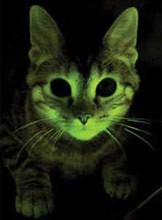Glow, Cat, Glow!

By Sara Nedley
Big cats and little cats. Black cats and white cats. Fluorescent cats and FIV-resistant cats? Although this might seem out of place, fluorescent cats might be the key to advancing feline immunodeficiency virus (FIV) and human immunodeficiency virus (HIV) research. Scientists have recently developed cats that have the ability to glow in the dark in order to further study FIV.
A Worldwide Pandemic
Millions of cats suffer and die from FIV/AIDS each year and HIV/AIDS has surged to pandemic proportions, having infected some 60 million people worldwide, resulting in more than 25 million deaths. FIV and HIV both cause AIDS (acquired immunodeficiency syndrome) by depleting infection-fighting T-cells.
It is understood that part of developing immunizations, as well as cures for the viruses, involves mimicking the evolution of different versions of protective proteins known as restriction factors. Current research has developed a method that utilizes monkey proteins already known to block FIV. To impart the protein to cats, a monkey gene is inserted into feline eggs before fertilization. To make it easier to check which cells have the monkey gene, the team also inserts a green fluorescent protein gene from the jellyfish to make them glow green. It is the kittens' ability to fluoresce that enables the scientists to know if the monkey restriction factor genes are present.
Encouraging Results
This method works so well that nearly all offspring from the modified eggs have been found to have the restriction factor genes. And these defense proteins are made throughout the cat's body. Two of the three original fluorescent cats have produced litters that make glowing cells as well. Also, when researchers tried to infect blood cells from the genetically modified kittens with FIV, the virus did not replicate well. Researchers' next plan is to test whether the cats are resistant to FIV. If the new cats are immune to FIV, the scientists hope to better understand how proteins can be used to prevent HIV infection.
Although fluorescent cats may not be the type of thing that is described in children's storybooks, perhaps they should be. They could possibly be the key to advancing FIV research, as well as HIV research for humans. Put those together and it could make for a very happy ending for felines and humans alike.
Classroom Discussion
- What is the difference between fluorescence and phosphorescence?
- What is the main function of a T-cell? What type of T-cell does FIV and HIV affect?

